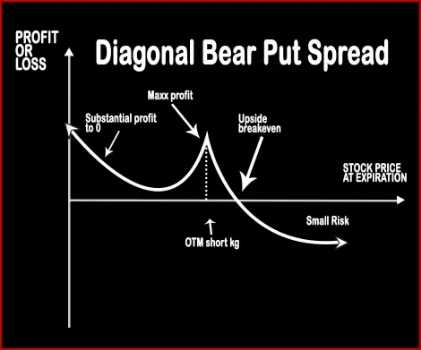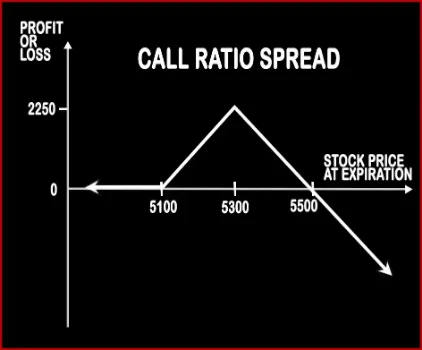Compare Strategies
| DIAGONAL BEAR PUT SPREAD | RATIO CALL SPREAD | |
|---|---|---|

|

|
|
| About Strategy |
Diagonal Bear Put SpreadWhen the trader is neutral – bearish in the near-month and bearish in the mid-month, he will apply Diagonal Bear Put Spread. This strategy involves buying Mid-Month ITM Put Options and selling (short/write) equal number of Near-Month OTM Put Options, of the same underlying asset. This strategy bags limited rewards with limited risk. |
Ratio Call Spread Option StrategyAs the name suggests, a ratio of 2:1 is followed i.e. buy 1 ITM Call and simultaneously sell OTM Calls double the number of ITM Calls (In this case 2). This strategy is used by trader who is neutral on the market and bearish on the volatility in the near future. Here profits will be capped up to the premium amount and risk will be potentially unlimited since he is .. |
DIAGONAL BEAR PUT SPREAD Vs RATIO CALL SPREAD - Details
| DIAGONAL BEAR PUT SPREAD | RATIO CALL SPREAD | |
|---|---|---|
| Market View | Bearish | Neutral |
| Type (CE/PE) | PE (Put Option) | CE (Call Option) |
| Number Of Positions | 2 | 3 |
| Strategy Level | Beginners | Beginners |
| Reward Profile | Limited | Limited |
| Risk Profile | Limited | Unlimited |
| Breakeven Point | This is a dynamic trade with many possible scenarios and future trades, it is impossible to calculate a breakeven. | Upper Breakeven Point = Strike Price of Short Calls + (Points of Maximum Profit / Number of Uncovered Calls), Lower Breakeven Point = Strike Price of Long Call +/- Net Premium Paid or Received |
DIAGONAL BEAR PUT SPREAD Vs RATIO CALL SPREAD - When & How to use ?
| DIAGONAL BEAR PUT SPREAD | RATIO CALL SPREAD | |
|---|---|---|
| Market View | Bearish | Neutral |
| When to use? | When the trader is neutral – bearish in the near-month and bearish in the mid-month, he will apply Diagonal Bear Put Spread. This strategy involves buying Mid-Month ITM Put Options and selling (short/write) equal number of Near-Month OTM Put Options, of the same underlying asset | This strategy is used by trader who is neutral on the market and bearish on the volatility in the near future. Here profits will be capped up to the premium amount and risk will be potentially unlimited since he is selling two calls. |
| Action | Sell 1 Near-Month OTM Put Option, Buy 1 Mid-Month ITM Put Option | Buy 1 ITM Call, Sell 2 OTM Calls |
| Breakeven Point | This is a dynamic trade with many possible scenarios and future trades, it is impossible to calculate a breakeven. | Upper Breakeven Point = Strike Price of Short Calls + (Points of Maximum Profit / Number of Uncovered Calls), Lower Breakeven Point = Strike Price of Long Call +/- Net Premium Paid or Received |
DIAGONAL BEAR PUT SPREAD Vs RATIO CALL SPREAD - Risk & Reward
| DIAGONAL BEAR PUT SPREAD | RATIO CALL SPREAD | |
|---|---|---|
| Maximum Profit Scenario | 'Premiums received - Initial premium to execute + Strike price - Stock Price on final month | Strike Price of Short Call - Strike Price of Long Call + Net Premium Received - Commissions Paid |
| Maximum Loss Scenario | When the stock trades up above the long-term put strike price. | Price of Underlying - Strike Price of Short Calls - Max Profit + Commissions Paid |
| Risk | Limited | Unlimited |
| Reward | Limited | Limited |
DIAGONAL BEAR PUT SPREAD Vs RATIO CALL SPREAD - Strategy Pros & Cons
| DIAGONAL BEAR PUT SPREAD | RATIO CALL SPREAD | |
|---|---|---|
| Similar Strategies | Bear Put Spread and Bear Call Spread | Variable Ratio Write |
| Disadvantage | Higher commissions due to additional trades. , Changes maximum profit potential of call or put spreads. | • Unlimited potential loss. • Complex strategy with limited profit. |
| Advantages | The Risk is limited. | • Downside risk is almost zero. • Investors can book profit from share prices moving within given limits. • Trader can maximise profit when the share closes at the upper breakeven point. |